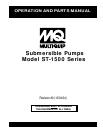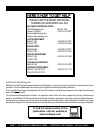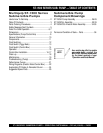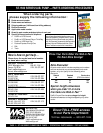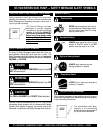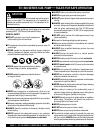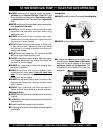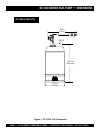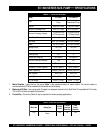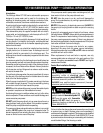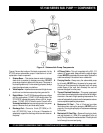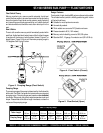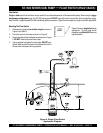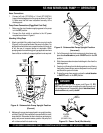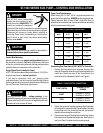
PAGE 6 — ST-1500 SERIES SUBMERSIBLE PUMPS — OPERATION & PARTS MANUAL — REV. #0 (10/04/04)
ST-1500 SERIES SUB. PUMP — RULES FOR SAFE OPERATION
Failure to follow instructions in this manual may lead to serious
injury or even death! This equipment is to be operated by
trained and qualified personnel only! This equipment is for
industrial use only.
The following safety guidelines should always be used when
operating the ST- 1500 Series Submersible Pumps:
GENERAL SAFETY
■
DO NOT operate or servicing this equipment
before reading this entire manual.
■
This equipment should not be operated by persons under 18
years of age.
■
NEVER operate this equipment without proper protective
clothing, shatterproof glasses, steel-toed boots and other
protective devices required by the job.
■
NEVER operate this equipment when not feeling
well due to fatigue, illness or taking medicine.
■
NEVER operate this equipment under the influence
or drugs or alcohol.
■
NEVER use accessories or attachments, which are not
recommended by Multiquip for this equipment. Damage to the
equipment and/or injury to user may result.
■
Manufacturer does not assume responsibility for any accident
due to equipment modifications.
■
Whenever necessary, replace nameplate, operation and safety
decals when they become difficult read.
■
ALWAYS check the machine for loosened threads or bolts
before starting.
■
NEVER operate the submersible pump in an explosive
atmosphere or near combustible materials. An explosion or fire
could result causing severe
bodily harm or even death.
■
ALWAYS make sure submersible pump is grounded.
■
NEVER use gas piping as an electrical ground.
■
DO NOT place hands or fingers inside pump when pump is
running.
■
ALWAYS make certain that the voltage supplied to the pump
is correct. Always read the pump's nameplate to determine
what the power requirements are. The ST-1500 series
submersible pumps require 115 VAC, 60 Hz (single-phase)
for normal operation.
■
DO NOT restrict the flow of the discharge hose as it may
cause overheating.
■
Be careful of discharge whipping under pressure.
■
Make sure pump installation is accordance with national
and local electrical codes.
■
ALWAYS have a qualified electrician perform the pump
wiring installation.
■
ALWAYS mount the control box in a vertical position
protected from the elements.
■
NEVER handle pump's AC power cord with
wet hands
.
■
NEVER let an extension cord or plug connection
lay in wate
r.
■
NEVER
stand in water
while AC power cord is connected
to a power source.
■
NEVER use a pump with a defective, frayed power cord.
Check the power cord on the pump for cuts in the insulation.
■
NEVER use a extension cord that is frayed or damaged
where the insulation has been cut.
■
ALWAYS make certain that proper extension cord has been
selected for the job. See Table 4.
■
NEVER attempt to use the power cord as a lifting or lowering
device for the submersible pump.
■
When raising or lowering of the submersible pump is
required, always attach an adequate rope or lifting device
to the correct lifting point (handle) on the pump.
■
ALWAYS place the pump in an upright position on a platform
before using. The platform will prevent the pump from
burrowing itself on soft sand or mud.
■
NEVER operate pump on its side.
■
DO NOT allow the pump to freeze in water.
■
NEVER leave an open pump chamber unattended.
■
The electrical voltage required to operate the pump can
cause severe injury or even death through physical contact
with live circuits.
ALWAYS
disconnect the electrical power
from the pump before performing maintenance on the pump.
CAUTION



